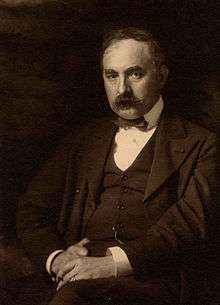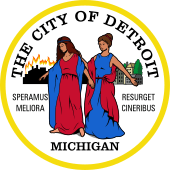Gari Melchers
| Gari Melchers | |
|---|---|
 Melchers, circa 1900 | |
| Born |
Julius Garbaldi Melchers August 11, 1860 Detroit, Michigan |
| Died |
November 30, 1932 (aged 72) Stafford County, Virginia |
| Nationality | American |
| Education | Ecole des Beaux Arts, Académie Julian, |
| Known for | Painting |
| Spouse(s) | Corinne Melchers |
| Awards | Legion of Honor |
Julius Garibaldi Melchers (August 11, 1860 – November 30, 1932) was an American artist. He was one of the leading American proponents of naturalism. He won a 1932 Gold medal from the American Academy of Arts and Letters.[1]
Biography
The son of German-born American sculptor Julius Theodore Melchers, Gari Melchers was a native of Detroit, Michigan, who at seventeen studied art at the Kunstakademie Düsseldorf under von Gebhardt and is associated with the Düsseldorf school of painting. After three years went to Paris, where he worked at the Académie Julian, and the Ecole des Beaux Arts, where he studied under Lefebvre and Boulanger.[2] Attracted by the pictorial side of Holland, he settled at Egmond. In 1882, Melchers presented The Letter, painted the previous year in Brittany, at the Paris Salon; this first presentation by a young artist was well received.[3] In 1884, he founded an art colony at Egmond-aan-Zee in Holland with American artist George Hitchcock.[4] His first important Dutch picture, The Sermon, brought him favorable attention at the Paris Salon of 1886.[3]
He became a member of the National Academy of Design, New York; the Royal Academy of Berlin; Société Nationale des Beaux Arts, Paris; International Society of Sculptors, Painters and Gravers, London, and the Secession Society, Munich; and, besides receiving a number of medals, his decorations include the Legion of Honor, France; the order of the Red Eagle, Germany; and knight of the Order of St Michael, Bavaria. In 1889, he and John Singer Sargent became the first American painters to win a Grand Prize at the Paris Universal Exposition. His paintings from the World Columbian Exposition (1893) held in Chicago are now in the Library at the University of Michigan in Ann Arbor.[5]
In 1903, he married Corinne Mackall, a Baltimore painter born in 1880, who studied at the Maryland Institute Practical School for the Mechanic Arts and at the Academy Colarossi.[4] Corinne was 20 years younger than her husband.[6]
In 1904 he was named an Officer in the French Legion of Honor.[7] In 1909 he was appointed Professor of Art at the Grand Ducal Saxony School of Art in Weimar, Germany. In 1915 he returned to New York City to open a studio at Abraham Archibald Anderson's Bryant Park Studios building. From 1920 to 1928 he served as the president of the New Society of Artists. He was a member of the Virginia Fine Arts Commission and a trustee of the Corcoran Gallery of Art.[8] He served as chairman of the Art Committee of the National Gallery of Art.[9]
He spent his final years at Belmont Estate in Falmouth, Virginia, near Fredericksburg. He died on November 30, 1932 in Falmouth, Virginia, at his 27-acre estate known as "Belmont".[3]
Works
Besides portraits, his chief works are: The Supper at Emmaus, in the Krupp collection at Essen; The Family, National Gallery, Berlin; Mother and Child, Luxembourg; and the decoration, at the Library of Congress, Washington, Peace and War.
The panels Peace and War were commissioned for the World's Columbian Exposition in Chicago of 1893.[4]
He completed a set for three murals in 1921 for the Detroit Public Library, depicting the history of Detroit. He subsequently was commissioned to paint four murals of notable Missourians (Eugene Field, Mark Twain, Major James Rollins, and Susan Blow) for the Governor's office in the Missouri State Capitol.[10]
Selected works
 Marriage, 1893
Marriage, 1893 Joan of Arc
Joan of Arc Mural of War, 1896.
Mural of War, 1896. Mural of Peace, 1896.
Mural of Peace, 1896.
The Sermon, 1886
The Bride, ca. 1907
Arranging the Tulips, before 1928 [11]
Notes
- ↑ http://www.artsandletters.org/awards2_popup.php?abbrev=Gold%20Art
- ↑ Baulch, Vivian M. (January 31, 1998).Detroit is fertile ground for art. Michigan History, The Detroit News. Retrieved on June 6, 2008.
- 1 2 3 "Gari Melchers, artist, Dead.". New York Times. December 1, 1932. Retrieved 2008-06-29.
- 1 2 3 Catron, Joanna D. The Story of Gari Melchers. Fredericksburg, VA: Belmont, the Gari Melchers Estate & Memorial Gallery, 2002. Print.
- ↑ Columbia Encyclopedia Sixth Edition (2008).Melchers, Gari. Retrieved on June 14, 2008.
- ↑ Theobald, Mary Miley (November 5, 2015). "A Man in Two Worlds". Virginia Living. Cape Fear Publishing. Retrieved June 27, 2016.
- ↑ American art annual, Volume 5
- ↑ "Gari Melchers Dies Suddenly." The Sunday Star (Washington, D.C.) November 30, 1932. Found at http://www.sil.si.edu/digitalcollections/art-design/artandartistfiles/vf_details.cfm?id=78152
- ↑ Mechlin, Leila. "Gari Melchers Memorial Exhibition Opens at the Corcoran Gallery of Art-- Representative Group of Artist's Work." The Sunday Star (Washington D.C.) October 22, 1933: 12. Found at http://www.sil.si.edu/digitalcollections/art-design/artandartistfiles/vf_details.cfm?id=78152
- ↑ Murals by Gari Melchers. Belmont, The Gari Melchers Memorial Gallery, Fredericksburg, VA. Nov 9 – December 12, 1979.
- ↑ National Museum of American Art; National Portrait Gallery (Smithsonian Institution) (1993). Revisiting the white city: American art at the 1893 World's Fair. Washington, D.C. : Hanover: National Museum of American Art and National Portrait Gallery, Smithsonian Institution ; Distributed by the University Press of New England. p. 286. ISBN 0937311014.
References
- Hind, C. Lewis (April 1908). "Gari Melchers: A Great American Painter Who Has Received More Recognition Abroad Than At Home". The World's Work: A History of Our Time. XV: 10092–10105. Retrieved 2009-07-10.
 This article incorporates text from a publication now in the public domain: Chisholm, Hugh, ed. (1911). "article name needed". Encyclopædia Britannica (11th ed.). Cambridge University Press.
This article incorporates text from a publication now in the public domain: Chisholm, Hugh, ed. (1911). "article name needed". Encyclopædia Britannica (11th ed.). Cambridge University Press.
External links
| Wikimedia Commons has media related to Gari Melchers. |
| Wikisource has the text of the 1911 Encyclopædia Britannica article Melchers, (Julius) Gari. |

